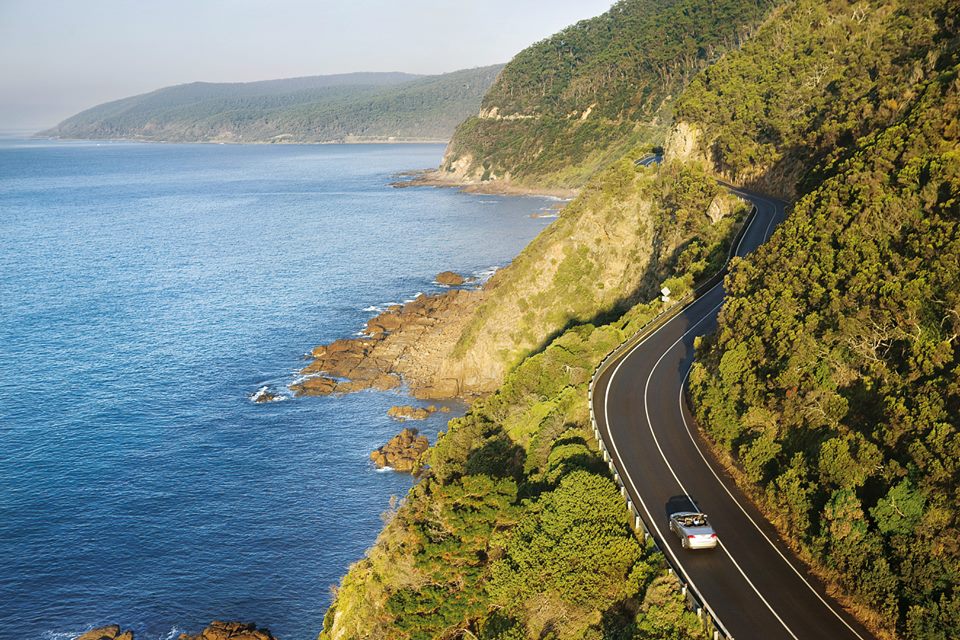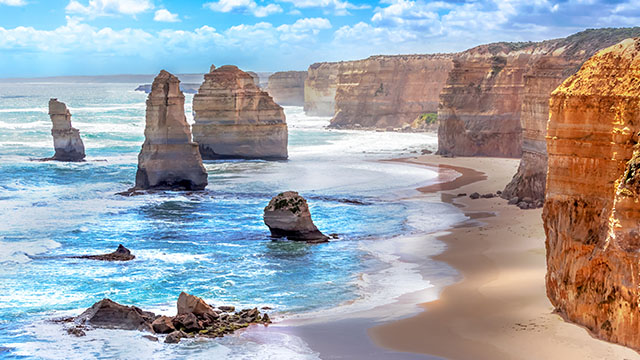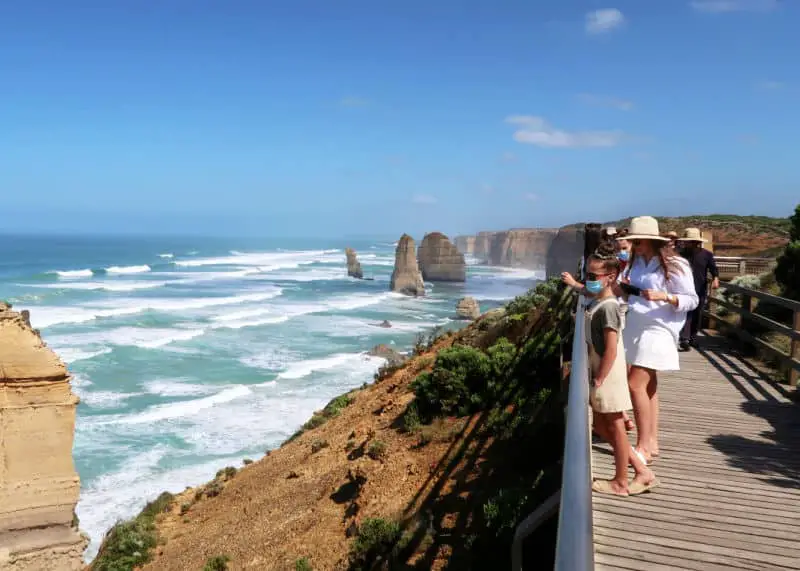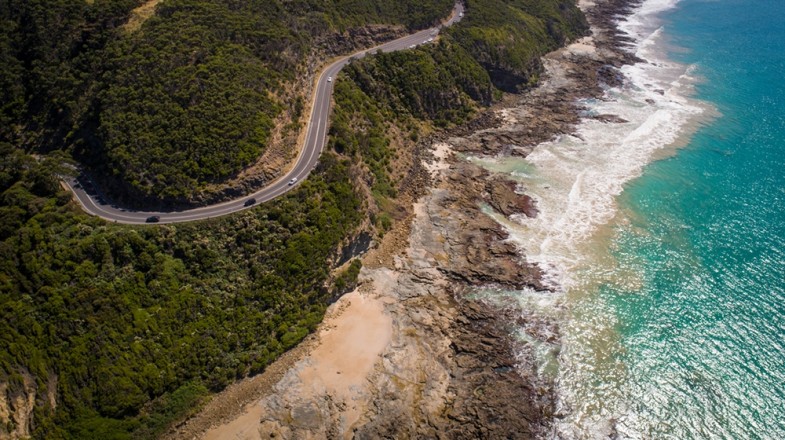Ever dreamt of hitting the open road, with the ocean breeze in your hair and a world of wonders awaiting you? Well, imagine no further! Whether you’re a seasoned traveler or someone itching for a new experience, the Great Ocean Road Trip promises a trip like no other. But what makes this road trip so special? Buckle up and come with me on this ride and let’s find out!
The Great Ocean Road, stretching along Australia’s southeastern coast, is not just a pathway, but a tour into nature’s grandeur. This iconic route, famed for it’s dramatic coastal views, lush rainforests and captivating wildlife, offers travelers a mesmerizing exploration of both natural beauty and historic significance, making it a must-visit for anyone seeking the essence of Australia’s coastal wonders.
History: More than just a scenic drive
The Great Ocean Road, with it’s breathtaking vistas and serene coastal stretches, might appear as just another picturesque route, but it’s foundation is deeply rooted in history. Initiated in 1919 and completed in 1932, this iconic pathway serves not merely as a testament to Australia’s natural beauty but as a poignant memorial to those who gave their lives during World War I.
Constructed primarily by returned soldiers, the road’s creation provided employment opportunities for many who found it challenging to reintegrate into post-war society. Their labor transformed a rugged coastline into a functional route, all the while facing challenging terrains and unpredictable weather. Every curve, bridge and viewpoint they carved stands as a silent tribute to their resilience and dedication.
The idea behind this colossal project was twofold: to create a lasting monument for the fallen comrades and to boost the region’s tourism, subsequently revitalizing Victoria’s coastal towns post-war. And it succeeded on both fronts. Over the years, the Great Ocean Road has evolved from a memorial route into a significant tourist attraction, drawing millions of visitors annually, eager to experience it’s unique blend of history and scenic charm.
One of the road’s standout attractions, The Twelve Apostles, serves as a stark reminder of nature’s relentless forces, with the limestone pillars continually reshaped by the crashing waves. Just like the soldiers who braved adversities to construct the road, these natural monuments endure the test of time, symbolizing perseverance.
Key Stops and Must-Visit Places

| Sr# | Location | Description |
|---|---|---|
| 1 | The Twelve Apostles | Majestic limestone stacks rising from the ocean, offering stunning sunrise and sunset views. |
| 2 | Loch Ard Gorge | A dramatic coastline with tales of shipwrecks; a perfect spot for history and nature lover. |
| 3 | London Arch | Once connected to the mainland, this natural arch offers spectacular oceanic views. |
| 4 | Lorne | A vibrant seaside town known for it’s arts community, boutiques and the stunning Teddy’s Lookout. |
| 5 | Torquay | The surfing capital of Australia, home to the world-famous Bells Beach and Surf World Museum. |
| 6 | Cape Otway Lightstation | Australia’s oldest working lighthouse, providing panoramic views of the Southern Ocean. |
| 7 | Kennett River | A top spot to see koalas in the wild; also known for it’s beautiful caravan park by the beach. |
| 8 | Gibsons Steps | An 86-step staircase offering a unique perspective of the Twelve Apostles from the beach level. |
| 9 | Aireys Inlet | Home to the Split Point Lighthouse, offering guided tours with a view. |
| 10 | Apollo Bay | A picturesque coastal town, perfect for seafood lovers and a gateway to the ancient Otway rainforest. |
Each of these spots captures the essence of the Great Ocean Road, combining natural splendors with enriching experiences. Whether you’re a nature lover, a history buff, or an adventure seeker, this iconic route has something to offer for every traveler.
Wildlife and Nature Encounters
The Great Ocean Road isn’t just about the mesmerizing views of the coastline; it’s a vibrant tapestry of life, offering unmatched wildlife and nature encounters. As the tarmac winds through varying landscapes, travelers are treated to a dynamic ecosystem teeming with diverse flora and fauna.
One of the most enchanting encounters is with the cuddly and ever-so-curious koalas. Especially around the Kennett River area, these creatures can often be spotted lounging on eucalyptus trees, munching on leaves, or simply dozing off. Their laid-back attitude offers a delightful contrast to the dynamism of the road itself. But koalas aren’t the only furry friends you’ll meet. The region is home to a myriad of other wildlife, including kangaroos hopping across grassy plains and wallabies darting amidst the bushes. As you venture closer to the coastal areas, be ready to spot colonies of fur seals basking on rocky outcrops or diving into the azure waters in search of a meal.
Birdwatchers, too, are in for a treat. From the colorful parrots and cockatoos that add a splash of color to the green canopy to the majestic birds of prey soaring high against the backdrop of expansive blue skies, the avian spectacle is truly captivating. And let’s not forget the intricate web of life beneath the surface. The rock pools scattered along the coastline are microcosms of marine life, housing starfish, anemones, crabs and tiny fish.
Best Seasons to Travel

- Spring (September to November)
- Pros: Wildflowers in full bloom, mild temperatures and the landscape is rejuvenated after the winter rains.
- Cons: Occasional unpredictable rain showers, which can be both a pro for those who love rain-soaked landscapes!
- Summer (December to February)
- Pros: Warm weather perfect for beach activities, longer daylight hours to explore and ideal for camping under the stars.
- Cons: Can get crowded as it’s peak tourist season and temperatures might soar on certain days.
- Autumn (March to May)
- Pros: A beautiful transition of foliage colors, especially in the hinterlands. Cooler temperatures make for comfortable drives and hikes.
- Cons: Cooler waters might not be ideal for swimming for everyone.
- Winter (June to August)
- Pros: Fewer tourists, making for a serene experience. The best time for whale watching as southern right whales migrate along the coast.
- Cons: Chilly weather with occasional rainfall and shorter daylight hours.
Each season on the Great Ocean Road offers it’s own unique charm, catering to different preferences. Whether you’re seeking the vibrancy of summer beaches or the tranquillity of a winter drive, there’s a perfect time for every traveler on this iconic route.
Preparing for Your Trip
| Tip# | Recommendation | Description |
|---|---|---|
| 1 | Plan Your Route | While spontaneity can be fun, having a rough idea of key stops ensures you don’t miss out on any must-visit spots. |
| 2 | Pack Layers | The weather can be unpredictable. Packing layers ensures you’re ready for sudden changes, especially during transitional seasons. |
| 3 | Check Local Regulations | Certain areas, especially camping zones, might have specific regulations. It’s wise to be informed in advance. |
| 4 | Car Maintenance | Ensure your vehicle is in top shape. Check the tires, brakes and fluids. Remember to keep a spare tire and essential tools. |
| 5 | Download Offline Maps | Mobile signal can be patchy in certain stretches. Having offline maps can be a lifesaver. |
| 6 | Stay Updated on Weather Forecasts | This will help you prepare for any sudden changes and ensure safety, especially if you’re planning hikes or beach visits. |
| 7 | Pack Snacks and Hydration | While there are eateries along the way, keeping snacks and water ensures you’re energized, especially during long stretches. |
| 8 | Respect Local Wildlife | Remember you’re in their home. Maintain distance, avoid feeding and drive carefully, especially during dawn and dusk. |
| 9 | Carry Cash | Some remote areas might not have ATM facilities or accept cards. It’s always handy to have some cash. |
| 10 | Respect Cultural Sites | The Great Ocean Road is rich in indigenous history. Ensure you’re respectful, especially in culturally sensitive areas. |
Roadside Delicacies and Eateries

The Great Ocean Road isn’t just a feast for the eyes, but for the palate too. As the road meanders along the coast, it introduces travelers to a rich tapestry of culinary delights reflective of Australia’s diverse food culture. Seaside towns like Apollo Bay and Lorne are particularly renowned for their seafood offerings. Here, one can indulge in fresh catches of the day, be it succulent lobsters, crispy fish and chips, or creamy seafood chowders. The freshness of the produce, combined with the expertise of local chefs, ensures that every dish tastes like the ocean on a plate.
Venturing further inland, the culinary landscape shifts to offer more hearty and rustic fare. The hinterland regions are dotted with charming cafes and bakeries, where travelers can relish handmade pies, freshly baked sourdough bread and artisanal cheeses. Moreover, the region’s rich dairy heritage means that creamy delights, from gelatos to milkshakes, are a must-try. And for those looking for a caffeine kick, the local coffee culture is strong, with numerous cafes serving up aromatic brews, perfectly paired with a slice of cake or a local pastry. Every meal or snack on this iconic road becomes a tour in itself, adding layers of flavor to the overall adventure.
Capturing Moments: Photography Tips
On the picturesque Great Ocean Road, every twist and turn offers a photo opportunity. To capture it’s essence, always consider the golden hours – the soft light of dawn or dusk brings out the landscape’s textures and tones. Use the rule of thirds to compose shots, placing horizons or landmarks off-center for a more dynamic image. Don’t shy away from different perspectives; sometimes, the best shots are taken from ground level or from an elevated viewpoint. Lastly, always be patient and observant. Nature, with it’s ever-changing moods, often rewards the patient photographer with unexpected moments of sheer brilliance.
FAQs
The Great Ocean Road stretches approximately 243 kilometers (151 miles) along the southeastern coast of Australia, from Torquay to Allansford.
While it’s technically possible to drive the entire length in a day, it’s advisable to take at least 2-3 days to truly appreciate the sights, delve into the culture, and enjoy the various attractions along the way.
Numerous tour operators offer guided trips, ranging from day tours to extended adventures. Local tourist information centers, as well as online platforms, provide details and reviews to help you choose the best fit.
Yes, the region is rich in indigenous history. Sites like Tower Hill are of cultural significance. When visiting such areas, it’s important to show respect and follow any guidelines or instructions provided.
The Great Ocean Road boasts a diverse range of accommodations, from luxury resorts and boutique B&Bs to campgrounds and hostels. It’s advisable to book in advance, especially during peak seasons.
Local Cultures and Traditions
The Great Ocean Road, while globally celebrated for it’s scenic beauty, is equally a tapestry of rich cultural heritages and traditions. This stretch of coastal wonderland has been home to indigenous communities for tens of thousands of years, long before the tarmac laid it’s mark.
At the heart of this cultural landscape are the First Nations peoples, primarily the Eastern Maar and Wadawurrung communities. These indigenous groups have a profound spiritual connection to the land and sea, seeing themselves as custodians rather than mere inhabitants. The stories of their ancestors, Dreamtime tales, are intricately woven into the very rocks, rivers and creatures of the region. By visiting places like Tower Hill, travelers can delve into these ancient narratives, getting glimpses of traditional life, from hunting and gathering to community ceremonies.
Moreover, art is a vibrant medium through which these tales come alive. The region boasts numerous indigenous art centers where traditional techniques, like dot painting and wood carving, unfold before one’s eyes. These artworks aren’t just decorative; they’re narrative, each pattern and symbol echoing age-old traditions and stories.
The post-colonial history of the Great Ocean Road has also added layers to it’s cultural fabric. The construction of the road itself, as a memorial by returned World War I soldiers, speaks of a community coming together in remembrance and rebuilding. This sense of community is evident in various local festivals, markets and gatherings that pepper the region’s calendar. Whether it’s celebrating the bounties of the sea, local produce, or music, these events showcase the harmonious blend of old and new, indigenous and settler cultures.
Conclusion
The Great Ocean Road, beyond it’s undoubted visual allure, is a profound tour through time, culture and nature’s marvels. As travelers get on this iconic stretch, they’re not just navigating miles of tarmac but are threading the stories of ancient indigenous tribes, the resilience of war veterans and the ever-evolving dance of nature. It’s a reminder that travel isn’t merely about destinations; it’s about the tales we weave, the memories we collect and the deeper understanding of the world we garner along the way. Whether a seasoned explorer or a first-time visitor, the Great Ocean Road promises a transformative experience, beckoning one to return, explore and rediscover time and again.


Yeah bookmaking this wasn’t a high risk decision great post! .
Terrific work! This is the type of information that are meant to be shared across the web. Shame on Google for no longer positioning this submit upper! Come on over and consult with my web site . Thanks =)